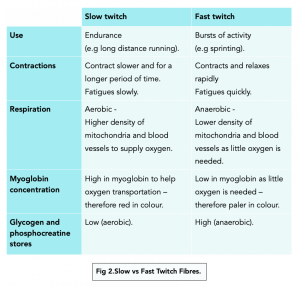Slow and Fast Twitch Muscles (A-level Biology)
Slow and Fast Twitch Muscles
Slow vs. Fast Twitch Fibres
Skeletal muscles contain a combination of slow twitch and fast twitch muscle fibres.

Slow twitch (Type I) and fast twitch (Type II) muscles refer to the two main types of muscle fibers, based on the speed and amount of force they can produce. Slow twitch muscles are highly endurance-focused, allowing them to perform repetitive, low-force movements for long periods of time. Fast twitch muscles, on the other hand, are better suited for producing short, intense bursts of force.
Slow twitch muscles are characterized by a high number of oxidative enzymes, which allow them to produce energy through the use of oxygen. They also contain a large number of blood vessels, providing them with a constant supply of oxygen and nutrients. Fast twitch muscles, in contrast, contain fewer oxidative enzymes and blood vessels, making them less efficient at using oxygen to produce energy. However, they contain more stored glycogen, which they can quickly convert into energy to produce powerful contractions.
The proportion of slow twitch and fast twitch fibers in an individual’s muscles can have a significant impact on their athletic performance. Individuals with a high proportion of slow twitch fibers tend to perform well in endurance-based activities, such as long-distance running, while those with a high proportion of fast twitch fibers tend to excel in power-based activities, such as sprinting and weightlifting.
To some extent, it is possible to change the type of muscle fibers one has through a combination of training and genetics. Resistance training, for example, has been shown to increase the number of fast twitch fibers in a muscle, while endurance training can increase the number of slow twitch fibers. However, genetics play a large role in determining the overall distribution of muscle fibers in the body, and the type of fibers an individual has is largely predetermined.
The proportion of slow twitch and fast twitch fibers in our muscles can impact our overall health and fitness in different ways. For example, individuals with a higher proportion of slow twitch fibers may be better suited for endurance-based activities, such as long-distance running, and may have a lower risk of injury during these types of activities. On the other hand, individuals with a higher proportion of fast twitch fibers may be better suited for power-based activities and may be less susceptible to fatigue during these types of activities.
The best way to train our muscles to become stronger and more efficient is to engage in a combination of resistance and endurance training. Resistance training, such as weightlifting, can increase the size and strength of our muscles, while endurance training, such as running or cycling, can increase our muscles’ ability to produce energy efficiently. It is also important to vary our workouts and include a variety of exercises in order to train all of the different muscle fibers in our body.
Common injuries or conditions associated with slow and fast twitch muscles can include muscle strains, sprains, and tears, as well as overuse injuries, such as tendonitis. Individuals with a high proportion of slow twitch fibers may be more susceptible to overuse injuries, while those with a high proportion of fast twitch fibers may be more susceptible to acute injuries, such as muscle strains or tears.





Still got a question? Leave a comment
Leave a comment